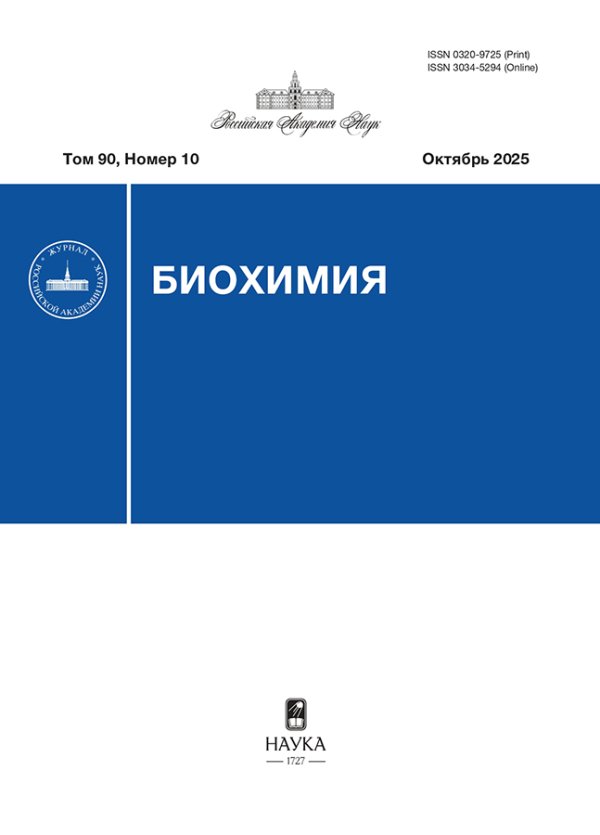Роль полиморфизма C1473G в гене триптофангидроксилазы-2 в эффектах острого введения этанола на экспрессию гена c-fos и метаболизм биогенных аминов в мозге мышей
- Авторы: Базовкина Д.В1, Фурсенко Д.В1, Науменко В.С1, Куликов А.В1
-
Учреждения:
- Институт цитологии и генетики СО РАН
- Выпуск: Том 88, № 3 (2023)
- Страницы: 355-367
- Раздел: Статьи
- URL: https://journals.rcsi.science/0320-9725/article/view/144647
- DOI: https://doi.org/10.31857/S0320972523030016
- EDN: https://elibrary.ru/QVYUTF
- ID: 144647
Цитировать
Полный текст
Аннотация
Ключевые слова
Об авторах
Д. В Базовкина
Институт цитологии и генетики СО РАН
Email: daryabazovkina@gmail.com
630090 Новосибирск, Россия
Д. В Фурсенко
Институт цитологии и генетики СО РАН
Email: daryabazovkina@gmail.com
630090 Новосибирск, Россия
В. С Науменко
Институт цитологии и генетики СО РАН
Email: daryabazovkina@gmail.com
630090 Новосибирск, Россия
А. В Куликов
Институт цитологии и генетики СО РАН
Email: daryabazovkina@gmail.com
630090 Новосибирск, Россия
Список литературы
- Sari, Y., Johnson, V. R., and Weedman, J. M. (2011) Role of the serotonergic system in alcohol dependence: from animal models to clinics, Prog. Mol. Biol. Transl. Sci., 98, 401-443, doi: 10.1016/B978-0-12-385506-0.00010-7.
- Marcinkiewcz, C. A. (2015) Serotonergic systems in the pathophysiology of ethanol dependence: relevance to clinical alcoholism, ACS Chem. Neurosci., 6, 1026-1039, doi: 10.1021/cn5003573.
- Lappalainen, J., Long, J. C., Eggert, M., Ozaki, N., Robin, R. W., Brown, G. L., Naukkarinen, H., Virkkunen, M., Linnoila, M., and Goldman, D. (1998) Linkage of antisocial alcoholism to the serotonin 5-HT1B receptor gene in 2 populations, Arch. Gen. Psychiatry, 55, 989-994, doi: 10.1001/archpsyc.55.11.989.
- Bonasera, S. J., Chu, H. M., Brennan, T. J., and Tecott, L. H. (2006) A null mutation of the serotonin 6 receptor alters acute responses to ethanol, Neuropsychopharmacology, 31, 1801-1813, doi: 10.1038/sj.npp.1301030.
- Wrzosek, M., Jakubczyk, A., Wrzosek, M., Matsumoto, H., Łukaszkiewicz, J., Brower, K. J., and Wojnar, M. (2012) Serotonin 2A receptor gene (HTR2A) polymorphism in alcohol-dependent patients, Pharmacol. Rep., 64, 449-453, doi: 10.1016/s1734-1140(12)70787-9.
- Boyce-Rustay, J. M., Wiedholz, L. M., Millstein, R. A., Carroll, J., Murphy, D. L., Daws, L. C., and Holmes, A. (2006) Ethanol-related behaviors in serotonin transporter knockout mice, Alcohol. Clin. Exp. Res., 30, 1957-1965, doi: 10.1111/j.1530-0277.2006.00241.x.
- Popova, N. K., Vishnivetskaya, G. B., Ivanova, E. A., Skrinskaya, J. A., and Seif, I. (2000) Altered behavior and alcohol tolerance in transgenic mice lacking MAO A: a comparison with effects of MAO A inhibitor clorgyline, Pharmacol. Biochem. Behav., 67, 719-727, doi: 10.1016/s0091-3057(00)00417-2.
- Kulikova, E. A., and Kulikov, A. V. (2019) Tryptophan hydroxylase 2 as a therapeutic target for psychiatric disorders: focus on animal models, Expert. Opin. Ther. Targets, 23, 655-667, doi: 10.1080/14728222.2019.1634691.
- Zhang, X., Gainetdinov, R. R., Beaulieu, J. M., Sotnikova, T. D., Burch, L. H., Williams, R. B., Schwartz, D. A., Krishnan, K. R., and Caron, M. G. (2005) Loss-of-function mutation in tryptophan hydroxylase-2 identified in unipolar major depression, Neuron, 45, 11-16, doi: 10.1016/j.neuron.2004.12.014.
- Bach, H., Arango, V., Kassir, S. A., Tsaava, T., Dwork, A. J., Mann, J. J., and Underwood, M. D. (2014) Alcoholics have more tryptophan hydroxylase 2 mRNA and protein in the dorsal and median raphe nuclei, Alcohol. Clin. Exp. Res., 38, 1894-1901, doi: 10.1111/acer.12414.
- Zupanc, T., Pregelj, P., Tomori, M., Komel, R., and Paska, A. V. (2011) TPH2 polymorphisms and alcohol-related suicide, Neurosci. Lett., 490, 78-81, doi: 10.1016/j.neulet.2010.12.030.
- Bragatti, J. A., Bandeira, I. C., de Carvalho, A. M., Abujamra, A. L., Leistner-Segal, S., and Bianchin, M. M. (2014) Tryptophan hydroxylase 2 (TPH2) gene polymorphisms and psychiatric comorbidities in temporal lobe epilepsy, Epilepsy Behav., 32, 59-63, doi: 10.1016/j.yebeh.2014.01.007.
- Zill, P., Preuss, U. W., Koller, G., Bondy, B., and Soyka, M. (2007) SNP- and haplotype analysis of the tryptophan hydroxylase 2 gene in alcohol-dependent patients and alcohol-related suicide, Neuropsychopharmacology, 32, 1687-1694, doi: 10.1038/sj.npp.1301318.
- Gacek, P., Conner, T. S., Tennen, H., Kranzler, H. R., and Covault, J. (2008) Tryptophan hydroxylase 2 gene and alcohol use among college students, Addict. Biol., 13, 440-448, doi: 10.1111/j.1369-1600.2008.00118.x.
- Zhang, X., Beaulieu, J. M., Sotnikova, T. D., Gainetdinov, R. R., and Caron, M. G. (2004) Tryptophan hydroxylase-2 controls brain serotonin synthesis, Science, 305, 217, doi: 10.1126/science.1097540.
- Osipova, D. V., Kulikov, A. V., and Popova, N. K. (2009) C1473G polymorphism in mouse tph2 gene is linked to tryptophan hydroxylase-2 activity in the brain, intermale aggression, and depressive-like behavior in the forced swim test, J. Neurosci. Res., 87, 1168-1174, doi: 10.1002/jnr.21928.
- Bazhenova, E. Y., Bazovkina, D. V., Kulikova, E. A., Fursenko, D. V., Khotskin, N. V., Lichman, D. V., and Kulikov, A. V. (2017) C1473G polymorphism in mouse tryptophan hydroxylase-2 gene in the regulation of the reaction to emotional stress, Neurosci. Lett., 640, 105-110, doi: 10.1016/j.neulet.2017.01.010.
- Bazhenova, E. Y., Fursenko, D. V., Kulikova, E. A., Khotskin, N. V., Sinyakova, N. A., and Kulikov, A. V. (2019) Effect of photoperiodic alterations on depression-like behavior and the brain serotonin system in mice genetically different in tryptophan hydroxylase 2 activity, Neurosci. Lett., 699, 91-96, doi: 10.1016/j.neulet.2019.01.041.
- Bazovkina, D. V., Lichman, D. V., and Kulikov, A. V. (2015) The C1473G polymorphism in the Tryptophan hydroxylase-2 gene: involvement in ethanol-related behavior in mice, Neurosci. Lett., 589, 79-82, doi: 10.1016/j.neulet.2015.01.043.
- Boone, E. M., Cook, M. N., Hou, X., and Jones, B. C. (1997) Sex and strain influence the effect of ethanol on central monoamines, J. Stud. Alcohol, 58, 590-599, doi: 10.15288/jsa.1997.58.590.
- Hitzemann, B., and Hitzemann, R. (1997) Genetics ethanol and the Fos response: a comparison of the C57BL/6J and DBA/2J inbred mouse strains, Alcohol. Clin. Exp. Res., 21, 1497-1507.
- Raymond, J. S., Wilson, B. B., Tan, O., Gururajan, A., and Bowen, M. T. (2019) Acute alcohol exposure dose-dependently alleviates social avoidance in adolescent mice and inhibits social investigation in adult mice, Psychopharmacology, 236, 3625-3639, doi: 10.1007/s00213-019-05335-8.
- Ogilvie, K. M., Lee, S., and Rivier, C. (1998) Divergence in the expression of molecular markers of neuronal activation in the parvocellular paraventricular nucleus of the hypothalamus evoked by alcohol administration via different routes, J. Neurosci., 18, 4344-4352.
- Nevo, I., and Hamon, M. (1995) Neurotransmitter and neuromodulatory mechanisms involved in alcohol abuse and alcoholism, Neurochem. Int., 26, 305-342, doi: 10.1016/0197-0186(94)00139-l.
- Vilpoux, C., Warnault, V., Pierrefiche, O., Daoust, M., and Naassila, M. (2009) Ethanol-sensitive brain regions in rat and mouse: a cartographic review, using immediate early gene expression, Alcohol. Clin. Exp. Res., 33, 945-969, doi: 10.1111/j.1530-0277.2009.00916.x.
- Abrahao, K. P., Salinas, A. G., and Lovinger, D. M. (2017) Alcohol and the brain: neuronal molecular targets, synapses, and circuits, Neuron, 96, 1223-1238, doi: 10.1016/j.neuron.2017.10.032.
- Ford, C. P. (2014) The role of D2-autoreceptors in regulating dopamine neuron activity and transmission, Neuroscience, 282, 13-22, doi: 10.1016/j.neuroscience.2014.01.025.
- Slotnick, B. M., and Leonard, C. M. (1975) A Stereotaxic Atlas of the Albino Mouse Forebrain, U. S. Dept. of Health, Education and Welfare, Rockville, 174 p.
- Naumenko, V. S., and Kulikov, A. V. (2006) Quantitative assay of 5-HT(1A) serotonin receptor gene expression in the brain, Mol. Biol. (Mosk), 40, 37-44, doi: 10.1134/s0026893306010079.
- Naumenko, V. S., Osipova, D. V., Kostina, E. V., and Kulikov, A. V. (2008) Utilization of a two-standard system in real-time PCR for quantification of gene expression in the brain, J. Neurosci. Methods, 170, 197-203, doi: 10.1016/j.jneumeth.2008.01.008.
- Bazovkina, D., Naumenko, V., Bazhenova, E., and Kondaurova, E. (2021) Effect of central administration of brain-derived neurotrophic factor (BDNF) on behavior and brain monoamine metabolism in new recombinant mouse lines differing by 5-HT1A receptor functionality, Int. J. Mol. Sci., 22, 11987, doi: 10.3390/ijms222111987.
- Robinson, S. L., Dornellas, A., Burnham, N. W., Houck, C. A., Luhn, K. L., Bendrath, S. C., Companion, M. A., Brewton, H. W., Thomas, R. D., Navarro, M., and Thiele, T. E. (2020) Distinct and overlapping patterns of acute ethanol-induced c-Fos activation in two inbred replicate lines of mice selected for drinking to high blood ethanol concentrations, Brain Sci., 10, 988, doi: 10.3390/brainsci10120988.
- Smith, M. L., Li, J., Cote, D. M., and Ryabinin, A. E. (2016) Effects of isoflurane and ethanol administration on c-Fos immunoreactivity in mice, Neuroscience, 316, 337-343, doi: 10.1016/j.neuroscience.2015.12.047.
- McBride, W. J. (2002) Central nucleus of the amygdala and the effects of alcohol and alcohol-drinking behavior in rodents, Pharmacol. Biochem. Behav., 71, 509-515, doi: 10.1016/s0091-3057(01)00680-3.
- LeMarquand, D., Pihl, R. O., and Benkelfat, C. (1994) Serotonin and alcohol intake, abuse, and dependence: findings of animal studies, Biol. Psychiatry, 36, 395-421, doi: 10.1016/0006-3223(94)91215-7.
- Badawy, A. A. (2002) Tryptophan metabolism in alcoholism, Nutr. Res. Rev., 15, 123-152, doi: 10.1079/NRR200133.
- Siesser, W. B., Zhang, X., Jacobsen, J. P., Sotnikova, T. D., Gainetdinov, R. R., and Caron, M. G. (2010) Tryptophan hydroxylase 2 genotype determines brain serotonin synthesis but not tissue content in C57Bl/6 and BALB/c congenic mice, Neurosci. Lett., 481, 6-11, doi: 10.1016/j.neulet.2010.06.035.
- Berger, S. M., Weber, T., Perreau-Lenz, S., Vogt, M. A., Gartside, S. E., Maser-Gluth, C., Lanfumey, L., Gass, P., Spanagel, R., and Bartsch, D. (2012) A functional Tph2 C1473G polymorphism causes an anxiety phenotype via compensatory changes in the serotonergic system, Neuropsychopharmacology, 37, 1986-1998, doi: 10.1038/npp.2012.46.
- Kirby, L. G., Zeeb, F. D., and Winstanley, C. A. (2011) Contributions of serotonin in addiction vulnerability, Neuropharmacology, 61, 421-432, doi: 10.1016/j.neuropharm.2011.03.022.
- Kelaï, S., Renoir, T., Chouchana, L., Saurini, F., Hanoun, N., Hamon, M., and Lanfumey, L. (2008) Chronic voluntary ethanol intake hypersensitizes 5-HT1A autoreceptors in C57BL/6J mice, J. Neurochem., 107, 1660-1670, doi: 10.1111/j.1471-4159.2008.05733.x.
- Melis, M., Diana, M., Enrico, P., Marinelli, M., and Brodie, M. S. (2009) Ethanol and acetaldehyde action on central dopamine systems: mechanisms, modulation, and relationship to stress, Alcohol, 43, 531-539, doi: 10.1016/j.alcohol.2009.05.004.
- Weinshenker, D., and Schroeder, J. P. (2007) There and back again: a tale of norepinephrine and drug addiction, Neuropsychopharmacology, 32, 1433-1451, doi: 10.1038/sj.npp.1301263.
- Tang, A., George, M. A., Randall, J. A., and Gonzales, R. A. (2003) Ethanol increases extracellular dopamine concentration in the ventral striatum in C57BL/6 mice, Alcohol. Clin. Exp. Res., 27, 1083-1089, doi: 10.1097/01.ALC.0000075825.14331.65.
- Sinyakova, N. A., Bazhenova, E. Y., Kulikova, E. A., Fursenko, D. V., and Kulikov, A. V. (2020) Effect of the C1473G polymorphic variant of the tryptophan hydroxylase 2 gene and photoperiod length on the dopamine system of the mouse brain [in Russian], Mol. Biol. (Mosk), 54, 60-68, doi: 10.31857/S0026898420010140.
Дополнительные файлы










